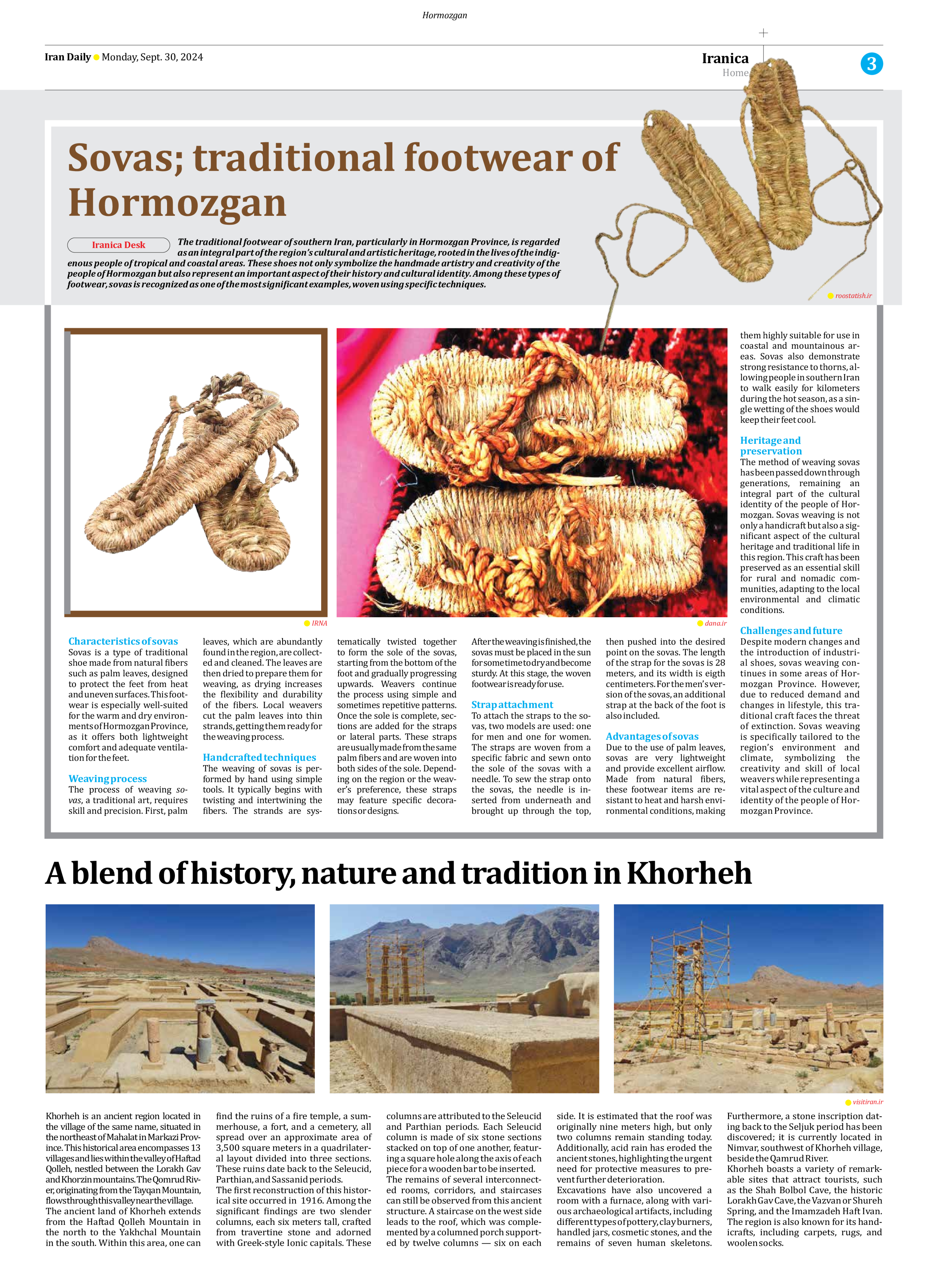
Sovas; traditional footwear of Hormozgan
The traditional footwear of southern Iran, particularly in Hormozgan Province, is regarded as an integral part of the region’s cultural and artistic heritage, rooted in the lives of the indigenous people of tropical and coastal areas. These shoes not only symbolize the handmade artistry and creativity of the people of Hormozgan but also represent an important aspect of their history and cultural identity. Among these types of footwear, sovas is recognized as one of the most significant examples, woven using specific techniques.
Characteristics of sovas
Sovas is a type of traditional shoe made from natural fibers such as palm leaves, designed to protect the feet from heat and uneven surfaces. This footwear is especially well-suited for the warm and dry environments of Hormozgan Province, as it offers both lightweight comfort and adequate ventilation for the feet.
Weaving process
The process of weaving sovas, a traditional art, requires skill and precision. First, palm leaves, which are abundantly found in the region, are collected and cleaned. The leaves are then dried to prepare them for weaving, as drying increases the flexibility and durability of the fibers. Local weavers cut the palm leaves into thin strands, getting them ready for the weaving process.
Handcrafted techniques
The weaving of sovas is performed by hand using simple tools. It typically begins with twisting and intertwining the fibers. The strands are systematically twisted together to form the sole of the sovas, starting from the bottom of the foot and gradually progressing upwards. Weavers continue the process using simple and sometimes repetitive patterns. Once the sole is complete, sections are added for the straps or lateral parts. These straps are usually made from the same palm fibers and are woven into both sides of the sole. Depending on the region or the weaver’s preference, these straps may feature specific decorations or designs.
After the weaving is finished, the sovas must be placed in the sun for some time to dry and become sturdy. At this stage, the woven footwear is ready for use.
Strap attachment
To attach the straps to the sovas, two models are used: one for men and one for women. The straps are woven from a specific fabric and sewn onto the sole of the sovas with a needle. To sew the strap onto the sovas, the needle is inserted from underneath and brought up through the top, then pushed into the desired point on the sovas. The length of the strap for the sovas is 28 meters, and its width is eigth centimeters. For the men’s version of the sovas, an additional strap at the back of the foot is also included.
Advantages of sovas
Due to the use of palm leaves, sovas are very lightweight and provide excellent airflow. Made from natural fibers, these footwear items are resistant to heat and harsh environmental conditions, making them highly suitable for use in coastal and mountainous areas. Sovas also demonstrate strong resistance to thorns, allowing people in southern Iran to walk easily for kilometers during the hot season, as a single wetting of the shoes would keep their feet cool.
Heritage and preservation
The method of weaving sovas has been passed down through generations, remaining an integral part of the cultural identity of the people of Hormozgan. Sovas weaving is not only a handicraft but also a significant aspect of the cultural heritage and traditional life in this region. This craft has been preserved as an essential skill for rural and nomadic communities, adapting to the local environmental and climatic conditions.
Challenges and future
Despite modern changes and the introduction of industrial shoes, sovas weaving continues in some areas of Hormozgan Province. However, due to reduced demand and changes in lifestyle, this traditional craft faces the threat of extinction. Sovas weaving is specifically tailored to the region’s environment and climate, symbolizing the creativity and skill of local weavers while representing a vital aspect of the culture and identity of the people of Hormozgan Province.







